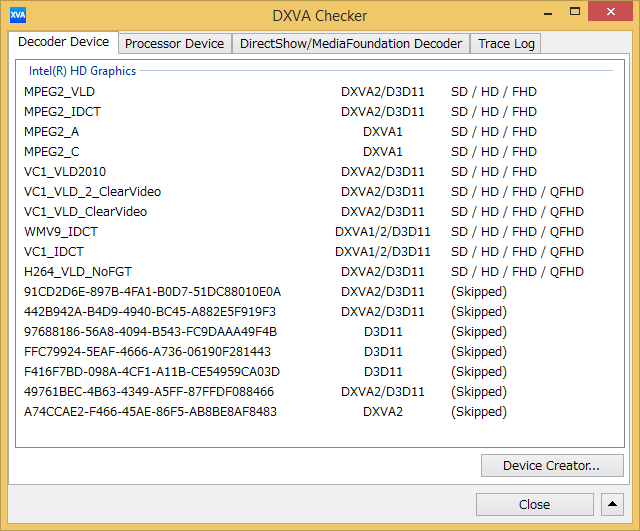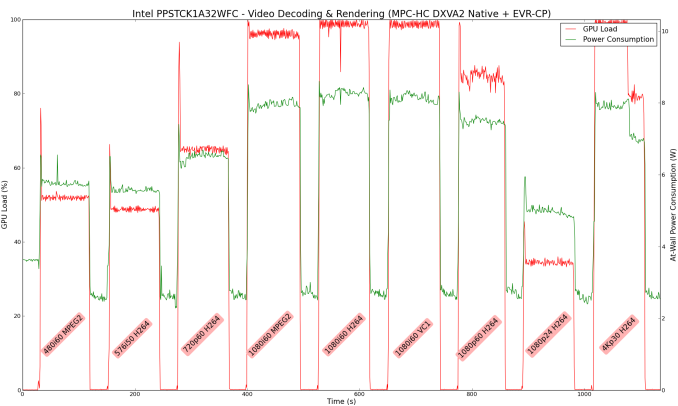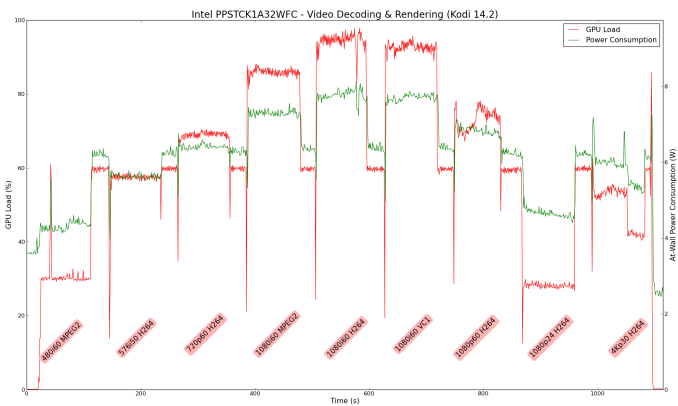Intel PPSTCK1A32WFC Bay Trail-T Compute Stick Review
by Ganesh T S on April 22, 2015 11:00 AM EST- Posted in
- Systems
- Intel
- Bay Trail
- HDMI Stick
HTPC Credentials
Usage of the Compute Stick as an entertainment platform is promoted by Intel as one of the use-cases. It is a bit surprising (given the form factor) that the Compute Stick has a fan. Subjectively, I was not comfortable with the acoustics in a 'office scenario' with the Compute Stick at the base of the monitor (connected via the HDMI extender cable) and myself seated around 70 cms. from it. The small diameter of the fan makes for a whining high-pitched noise, and it is compounded by the fact that it starts and stops depending on the SoC load.
Objectively speaking, Intel provided an acoustics rating of 28 dB at 1m distance for the noisiest mode. If the Compute Stick were to be hidden behind the TV, it is unlikely that users can hear such low noise at typical television viewing distances. It is not ideal, but Intel indicated that the performance of the device needs proper thermals. In order to to balance the very small size along with overall cost and performance, they went with a small fan as the optimal thermal solution. Now that we have got the acoustics out of the way, let us move on to the other HTPC aspects.
Refresh Rate Accurancy
Starting with Haswell, Intel, AMD and NVIDIA have been on par with respect to display refresh rate accuracy. The most important refresh rate for videophiles is obviously 23.976 Hz (the 23 Hz setting). The Intel PPSTCK1A32WFC has no trouble with refreshing the display appropriately in this setting, but it is not as accurate as Haswell or Broadwell or even other Bay Trail-based systems (refreshing at 23.973 Hz instead of 23.976 Hz).
The gallery below presents some of the other refresh rates that we tested out. The first statistic in madVR's OSD indicates the display refresh rate.
Network Streaming Efficiency
Evaluation of OTT playback efficiency was done by playing back our standard YouTube test stream and five minutes from our standard Netflix test title. Using HTML5, the YouTube stream plays back a 720p encoding. Since YouTube now defaults to HTML5 for video playback, we have stopped evaluating Adobe Flash acceleration. Note that only NVIDIA exposes GPU and VPU loads separately. Both Intel and AMD bundle the decoder load along with the GPU load. The following two graphs show the power consumption at the wall for playback of the HTML5 stream in Mozilla Firefox (v 37.0.1).

GPU load was around 51.56% for the YouTube HTML5 stream and 4.53% for the steady state 6 Mbps Netflix streaming case. Mozilla Firefox is terribly inefficient in terms of power for YouTube playback. The same test stream, when played back in Internet Explorer, consumed only 3.55 W on an average and had a GPU load of 9.1% for the same H.264 stream.
Netflix streaming evaluation was done using the Windows 8.1 Netflix app. Manual stream selection is available (Ctrl-Alt-Shift-S) and debug information / statistics can also be viewed (Ctrl-Alt-Shift-D). Statistics collected for the YouTube streaming experiment were also collected here. The power efficiency of the Compute Stick platform comes to the fore here.

Decoding and Rendering Benchmarks
The form factor of the Compute Stick and the internal components make it clear that consumers are not going to play back videos using the madVR renderer. Instead, it is highly likely that Kodi will be used as the interface for media playback. We evaluated performance under MPC-HC + EVR-CP and Kodi 14.2 for our test suite. Prior to those results, let us take a look at the codecs that are hardware-accelerated by the Bay Trail-T SoC.
As expected, we have acceleration for MPEG-2, VC1, WMV9 and H.264. HEVC is not necessary for such a platform at this point in time.
In our earlier reviews, we focused on presenting the GPU loading and power consumption at the wall in a table (with problematic streams in bold). Starting with the Broadwell NUC review, we decided to represent the GPU load and power consumption in a graph with dual Y-axes. Nine different test streams of 90 seconds each were played back with a gap of 30 seconds between each of them. The characteristics of each stream are annotated at the bottom of the graph. Note that the GPU usage is graphed in red and needs to be considered against the left axis, while the at-wall power consumption is graphed in green and needs to be considered against the right axis.
Frame drops are evident whenever the GPU load consistently stays above the 85 - 90% mark. In addition to tracking that aspect in the graphs below, we also get an idea of the system's power efficiency for decode and playback of some common codecs.
The above graph suggests that the Compute Stick is likely to drop frames when deinterlacing of high frame rate content is required. It is possible that EVR, the native renderer, will perform better than EVR-CP.
Kodi doesn't deinterlace content by default - so, the GPU load goes unreasonably high only for the 1080i60 stream. Another aspect to observe with Kodi is that 'idling' at the XBMC interface consumes around 60% of the GPU resources and the power penalty is around 6 W. Depending on the codec and frame rate, the GPU load and power consumption might be lower or higher than the 'idle' state. For example, 480i60 and 1080p24 videos play back within the 5 W power envelop.
Note on HD Audio Bitstreaming
As of April 2015, the Intel graphics drivers for Bay Trail-T (32-bit) have support only for bitstreaming of DTS, Dolby Digital and Dolby Digital Plus. This means that Netflix and other similar OTT sites are in the clear. However, users hoping to take advantage of lossless HD audio in Blu-ray backups are going to be disappointed. In any case, streaming of Blu-rays over a 802.11n Wi-Fi network will result in a bad user experience. So, it is possible that the absence of HD audio bitstreaming will not bother too many consumers.



















103 Comments
View All Comments
jabber - Thursday, April 23, 2015 - link
Yeah I was wondering this. Once you have Windows fully installed you can usually claw back 3-5GB easy. I've got fully setup Windows 10 preview installs down to around 11GB doing such things. DiskCleanup works wonders. 32GB is plenty for a light on the go setup. Why do folks still need to carry around TBs of data?zodiacfml - Friday, April 24, 2015 - link
Speaking of storage, Ganesh can you confirm if this runs using WIMBoot?I worked on WIMboot using a 32GB tablet with 19GB free space which includes educational software, latest updates, and Office 365 in the recovery image/partition.
ganeshts - Friday, April 24, 2015 - link
I suspect not, because I saw only 17.1 GB of 23 GB free after initial setup - no other programs installed.zodiacfml - Saturday, April 25, 2015 - link
Thanks. I wonder why they didn't bothered. I find that it works pretty well, might be even faster if the storage device has slow read speeds.I hope I could convince people in the office to purchase one of this. It looks fun especially after seeing the fan and heatsink in Tom's review.
Laststop311 - Thursday, April 23, 2015 - link
So basically the only use for this thing is turning a dumb tv into a smart tv? If you already have a DLNA compatible tv with a built in web browser what extra does this little stick bring to the table? I can already use DLNA streaming to stream movies, tv shows, and mp3's to my tv and I can use the built in web browser to browse the web and the built in youtube and netflix apps to use those services. I guess this thing is cool if your tv is a very basic model with no extra features or older before those features became almost standard.Other than streaming video and browsing the web there is nothing else this stick will be powerful enough to do and good smart tv's can already do all of this. You need an HTPC if you want to do other PC things on your tv as this stick doesn't have the power.
I have an ncase m1 htpc running an i7-3770t undervolted to 1.05v at stock clocks cooled with Noctua NH-C12P SE14 140mm fan with the ULNA adapter attached and coollaboratory liquid metal ultra TIM and the Noctua NF-B9-1600 92mm rear exhaust with ULNA adapter attached. Asus P8Z77-I deluxe mobo. 4x 120mm noctua intake fans all with ULNA attached (2x side 2x bottom). Silverstone 600 watt SFX PSU 80+ gold semi fanless mode. No optical drive have 512GB samsung 840 pro in slim optical drive bay. GSkill TridentX 2x8GB 2400Mhz Cas 10 DDR3. Recently added EVGA 4GB GTX 960 custom repasted with coollaboratory liquid metal ultra which replaced the GTX 660ti mainly for the hardware HEVC decode and the ability of the fans to shut off completely below 60C and a little for the gaming increase also for the decrease in power and heat. It has no standard HDD's and uses my NAS for bulk storage of movies and tv shows connected via 1Gbit ethernet as my house was completely wired for ethernet before wifi became a reliable thing. OS, apps and games installed on SSD.
Even though this system has infinite more power than the compute stick believe it or not it actually runs dead silent and may actually even be quieter. Even though this has 6 fans + 2 gpu fans and 1 psu fan the 6 noctua fans with ULNA adapters cannot be heard over ambient noise at all. The psu fan and gpu fans do not even turn on unless you are playing a demanding game and even then they can only be very slightly heard if there is a lull in the noise coming from inside the actual game. Haven't tested how demanding the hardware HEVC decode is on the gpu if it's enough to push the gpu over 60C to turn the fans on as I don't have a 4k tv yet but the way the ncase is set up the 2x 120mm intake fans on the bottom are just centimeters away from the GPU so the gpu gets cold air forced on to it at all times whether its fans are on or not which really helps from keeping the noisy gpu fans from ever coming on in all but the most demanding situations.
Yes I know the price difference is massive. As my system was 10 times the cost of the compute stick 1500 vs 150 and that doesn't even count the NAS system used to augment it. But I think it's money well spent as I can do more than 10 times the tasks the compute stick can at more than 10 times the speed.
I can only see the most casual of casual users ever wanting a stick like this. A real enthusiast will build a real HTPC and the 1500 is a large initial outlay but most of the parts can be reused for a long time coming. I won't need a new cpu and mobo till at least the 7nm tock and won't get a new ssd till the new cpu and mobo upgrade which will be an nvme ultra m2 with 1TB capacity and won't get a new GPU till at least 10nm as well unless major progress is made on video decoders. The case will be a forever thing as well as the PSU and fans at least until they die. Will have to get new ram only because of DDR4 taking over by the time the 7nm tock rolls around but prices will be like ddr3 prices now by then. The stick is so underpowered you will be buying new generations of it every single year out of desperation for more power and pretty soon the money difference isn't as large as it initially looks and you get so much more enjoyment out of a real HTPC.
Haravikk - Thursday, April 23, 2015 - link
I could understand the problems and compromises (like the fan) in a prototype, but this seems really poor for a final product. They could easily have avoided the fan by making the casing out of aluminium; sure it would be added cost, but not much, and would have resulted in a far superior product, as I don't know about anyone else, but I expect a stick computer to be silent like any good mobile phone.The Wi-Fi performance is also pretty shocking; this is a device that, by its nature, is likely to be stuck on the back of a monitor, so it's not an ideal location for good Wi-Fi reception to begin with, which means that good Wi-Fi performance is a prerequisite to any device of this type.
It's a shame, as it's not a bad processor with all things considered, and the other specs seem decent as well.
elbert - Thursday, April 23, 2015 - link
Were is the 1GB linux version for $89?stefstef - Thursday, April 23, 2015 - link
nice product. adds some value to a tv and fits perfectly in the gap between pc and mobile gadgets. would be already enough for me to do my work but, as with other products, the usability seems to be cut down due to the 2gb ram.Teetu - Thursday, April 23, 2015 - link
This is a good first effort. The second version, or competitors follow up, will be good enough to replace my ps3!mofongo7481 - Friday, April 24, 2015 - link
It might be fun to stream some Steam games from a gaming machine to it while hooked up to the TV.